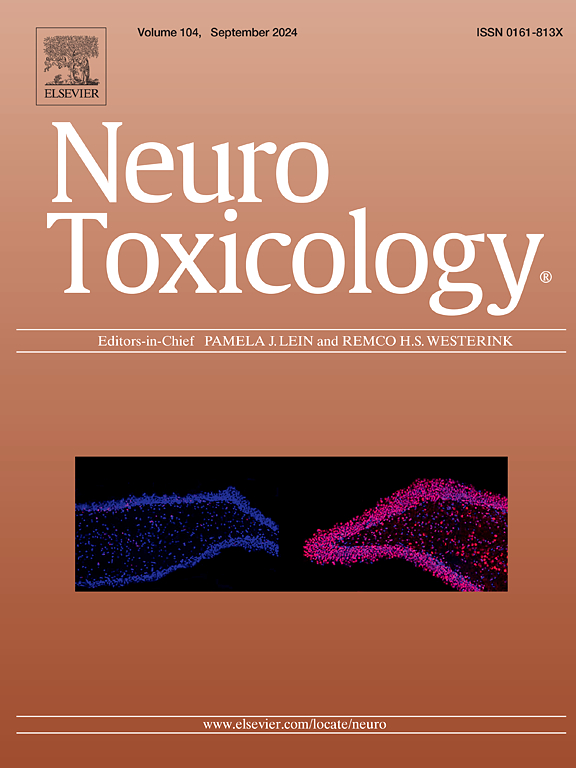Vilazodone exposure during pregnancy: Effects on embryo-fetal development, pregnancy outcomes and fetal neurotoxicity by BDNF/Bax-Bcl2/5-HT mediated mechanisms
IF 3.4
3区 医学
Q2 NEUROSCIENCES
引用次数: 0
Abstract
The high prevalence of major depressive disorder (MDD) among women of childbearing age necessitates careful consideration of antidepressant use during pregnancy. Although newer antidepressants, such as Vilazodone (VLZ), are preferred for their enhanced therapeutic profiles; however, their safety during pregnancy and long-term effects on offspring brains remain inadequately addressed. Therefore, this study aimed to investigate the reproductive and developmental neurotoxicity of VLZ given at equivalent therapeutic doses during gestation in a rat model. Pregnant Wistar dams were orally administered either with 1 mg/day or 2 mg/day of VLZ from gestation day (GD) 6–21. The dams were sacrificed at GD 21, and the placentas and fetuses were collected. Fetal brains were then subjected to neurohistopathological, neurochemical, and biochemical analysis. Prenatal exposure to VLZ at 2 mg/day resulted in significant maternal, reproductive, and embryo-fetal toxicity, characterized by reduced food intake, diminished weight gain in pregnant dams, and smaller litter sizes, along with decreased fetal and placental weights. These effects were associated with developmental neurotoxicity, which manifested as decreased fetal brain size and weight, a substantial reduction in neocortical layer thickness, brain-derived neurotrophic factor (BDNF) expression, serotonin, dopamine, and norepinephrine neurotransmitter levels (5-HT, DA, and NE), and increased apoptotic activity (Bax and Bcl-2 ratio) and acetylcholinesterase levels in the developing brain. Our findings indicate that prenatal VLZ exposure interfere with crucial brain development processes involving the BDNF/Bax-Bcl2/5-HT signalling pathways, leading to long-lasting neurodevelopmental impairments. This study is the first to document the adverse effects of VLZ on fetal brain development, highlighting the need for further research to assess the safety of VLZ use during pregnancy.
孕期接触维拉唑酮:BDNF/Bax-Bcl2/5-HT介导机制对胚胎-胎儿发育、妊娠结局和胎儿神经毒性的影响。
育龄妇女中重度抑郁障碍(MDD)的发病率很高,因此有必要慎重考虑孕期使用抗抑郁药的问题。尽管维拉唑酮(VLZ)等新型抗抑郁药物因其更佳的治疗效果而受到青睐,但它们在孕期的安全性以及对后代大脑的长期影响仍未得到充分关注。因此,本研究旨在以大鼠为模型,研究同等治疗剂量的 VLZ 在妊娠期间对生殖和发育的神经毒性。从妊娠第 6 天到第 21 天,给妊娠 Wistar 母鼠口服 1 毫克/天或 2 毫克/天的 VLZ。母鼠在妊娠期第 21 天被处死,并收集胎盘和胎儿。然后对胎儿大脑进行神经组织病理学、神经化学和生化分析。产前接触 2 毫克/天的 VLZ 会对母体、生殖和胚胎-胎儿产生显著毒性,表现为摄食量减少、妊娠母体体重增加减少、产仔数减少以及胎儿和胎盘重量减少。这些影响与发育神经毒性有关,表现为胎儿大脑大小和重量减少,新皮质层厚度、脑源性神经营养因子(BDNF)表达、5-羟色胺、多巴胺和去甲肾上腺素神经递质水平(5-HT、DA 和 NE)大幅降低,以及发育中大脑的凋亡活性(Bax 和 Bcl-2 比率)和乙酰胆碱酯酶水平升高。我们的研究结果表明,产前接触 VLZ 会干扰涉及 BDNF/Bax-Bcl2/5-HT 信号通路的关键大脑发育过程,从而导致长期的神经发育障碍。这项研究首次记录了VLZ对胎儿大脑发育的不良影响,强调了进一步研究评估孕期使用VLZ安全性的必要性。
本文章由计算机程序翻译,如有差异,请以英文原文为准。
求助全文
约1分钟内获得全文
求助全文
来源期刊

Neurotoxicology
医学-毒理学
CiteScore
6.80
自引率
5.90%
发文量
161
审稿时长
70 days
期刊介绍:
NeuroToxicology specializes in publishing the best peer-reviewed original research papers dealing with the effects of toxic substances on the nervous system of humans and experimental animals of all ages. The Journal emphasizes papers dealing with the neurotoxic effects of environmentally significant chemical hazards, manufactured drugs and naturally occurring compounds.
 求助内容:
求助内容: 应助结果提醒方式:
应助结果提醒方式:


